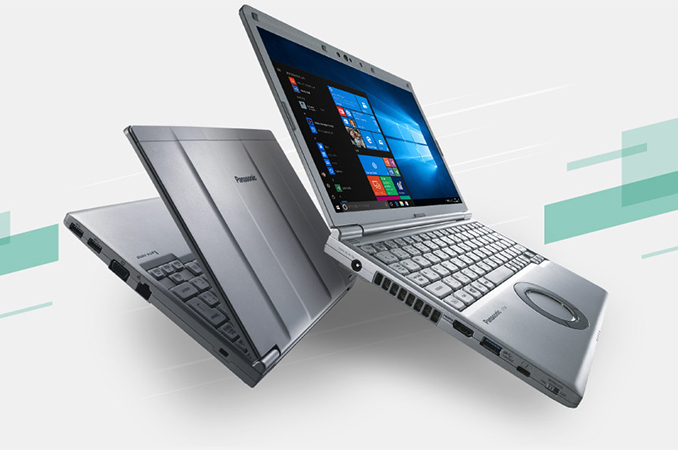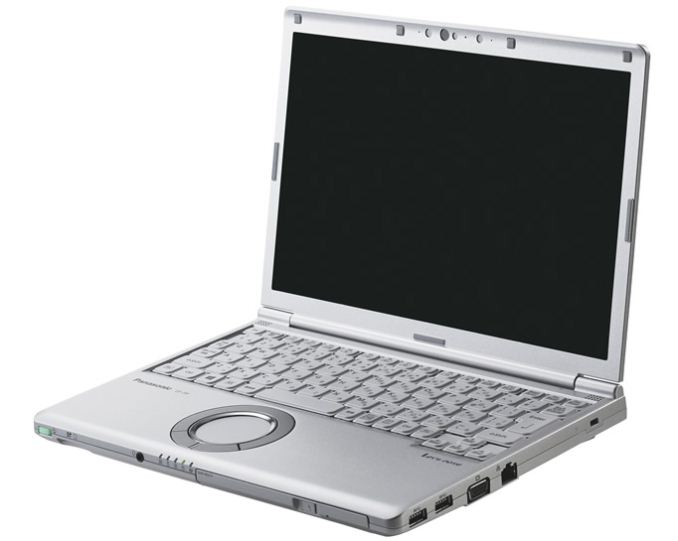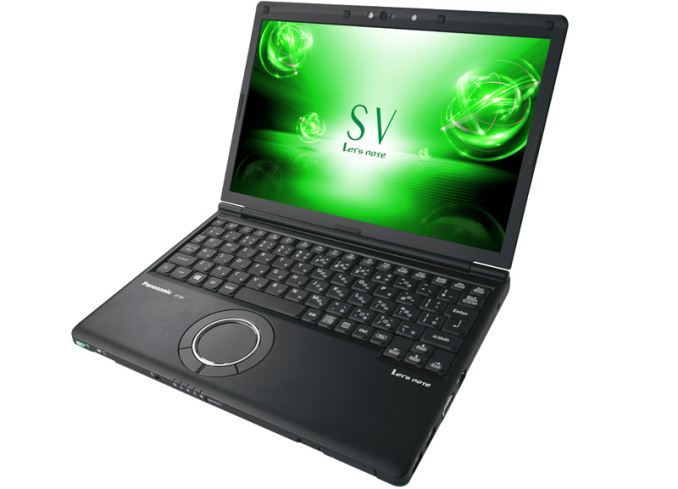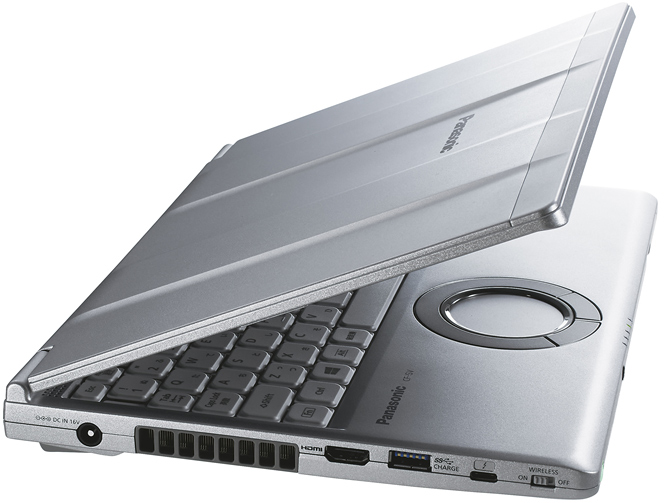Panasonic Unveils Let’s Note SV7: 12.1-Inch, Quad-Core CPU, TB3, ODD, 21 Hrs, 2.4 Lbs
by Anton Shilov on February 13, 2018 11:00 AM EST- Posted in
- Notebooks
- Intel
- Panasonic
- Core 8th Gen
- Let's Note

Panasonic has upgraded its 12.1-inch series laptops with Intel’s quad-core 8th Generation Core i5/i7 CPUs. The new Panasonic Let’s Note CF-SV7-series notebooks are the only ultra-compact PCs to feature Intel’s latest mobile processors, a Thunderbolt 3 interconnection, an optical drive and an optional LTE modem in a package that weighs from 999 grams to 1.124 kilograms (2.2 – 2.47 pounds).
Panasonic is one of a few companies nowadays that offers highly-integrated ultra-compact laptops with optical disc drives. These machines are very light because they are made of plastic (they are still rugged enough and can be dropped from a height of 76 cm) and their weight is about a kilogram, but they are not ultra-thin like modern notebooks from Apple, HP or Lenovo. To a large degree, they are relatively thick because they are designed to offer their owners the best possible connectivity, feature set and battery life, something that we usually see on 14”/15.6” laptops from other manufacturers. In Europe and the U.S. many people nowadays prefer ultra-thin PCs even if they lack replaceable batteries or certain ports (and I am not even talking about laptops with ODDs — they have become exotic). User preferences are different in Japan, which is why Panasonic still offers 12”-class laptops with optical drives, thick replaceable batteries and plenty of connectors.
The Panasonic Let’s Note CF-SV7 family of notebooks succeeds the company’s Let’s Note CF-SZ6 lineup that featured a similar appearance, a 12.1” WUXGA (1920×1200) display, comparable weight and dimensions as well as a very long battery life of up to 21 hours (enabled by a removable accumulator). Meanwhile, even though the CF-SV7 continues traditions of the CF-SZ6, it does not mean that Panasonic just installed new quad-core CPUs into an old chassis.
The Let’s Note SV7-series based on Intel’s quad-core Core i5/i7 processors actually uses a new chassis that is 24.5 mm thick (down from 25.3 mm in case of the SZ6) and features a new cooling system for its new CPUs. Because of the new cooler, the SV7 PCs are a bit heavier than their predecessors, but even when equipped with a high-capacity “L” battery, their weight does not exceed 1.124 kilograms. Besides the new quad-core 8th Generation Core i5/i7 processors, Panasonic’s latest SV7-series laptops obtained a Thunderbolt 3 port, a rare feature for 12”-class mobile computers.
Exact configurations of Panasonic’s Let’s Note CF-SV7 vary greatly. Retail versions of the CF-SV7 are equipped with Intel’s Core i5-8250U or Core i7-8550 CPUs, 8 GB of LPDDR4-1866 memory and a SATA SSD (128 GB – 1 TB). Meanwhile, built-to-order models bought directly from Panasonic can be customized to feature Intel’s Core i5-8350U or Core i7-8650U, 16 GB RAM as well as a 1 TB PCIe SSD. As for connectivity, the systems are outfitted with an 802.11ac + Bluetooth 4.1 wireless module, a GbE connector, three USB 3.0 Type-A ports, a D-Sub output, an HDMI 2.0 header (supporting 4Kp60 resolution), a TRRS audio connector and so on. In addition, the systems feature stereo speakers, a microphone, a 720p webcam with an IR sensor compatible with Windows Hello, an SD card reader supporting SDHC/SDXC cards with UHS-II interface as well as a CD/DVD burner/reader or a Blu-ray reader/CD/DVD burner. Some systems come with a 4G/LTE modem, other can be configured to include a 1 TB HDD in addition to a 128 GB SSD. It is noteworthy that the width of a key on SV7’s keyboard is 19 mm, comparable to that of a modern MacBook Pro. Meanwhile, the new SV7 continues to feature Panasonic’s round touchpad that does not look too comfy.
Besides high integration, the Let’s Note CF-SV7-series can be proud of its battery life. When equipped with an “S” battery and an SSD, the laptop can work for up to 14 hours, according to Panasonic. Meanwhile, if an “L” accumulator is installed, the system is rated for 21 hours, probably a record for 12”-class PCs in general.
| General Specifications of Panasonic Let's Note CF-SV7-Series | |||||
| "High-End" | "Mainstream" | "Entry" | |||
| Display | 12.1" non-glossy 1920×1200 resolution |
||||
| SoC | Core i7-8550U Core i7-8650U* |
Core i5-8250U Core i5-8350U* |
|||
| RAM | 8 GB LPDDR3 16 GB LPDDR3* |
||||
| Storage | 256 - 512 GB SSD SATA up to 1 TB SSD PCIe* |
128 - 256 GB SSD SATA up to 1 TB SSD PCIe* |
1 TB HDD 128 GB SSD + 1 TB HD* up to 1 TB SSD PCIe* |
||
| ODD | CD/DVD burner BD reader/CD/DVD burner* No ODD* |
- | |||
| Camera | 720p webcam with IR sensor for Windows Hello | ||||
| Wireless | 802.11ac Wi-Fi Bluetooth 4.1 optional 4G/LTE modem 300/50 Mbps |
||||
| I/O ports | 3 × USB 3.0 Type-A 1 × Thunderbolt 3/USB Type-C 1 × HDMI 1 × D-Sub 1 × GbE SD card reader with UHS-II support |
||||
| Audio | Integrated speakers and microphone 1 × TRRS 3.5-mm jack for headset |
||||
| Dimensions | 283.5 × 203.8 × 24.5 mm | ||||
| Weight | 999 - 1124 grams | ||||
| Battery Life Based on JEITA 2.0 | Up to 21 hours with L battery and SSD Up to 14 hours with S battery and SSD Up to 11 hours with S battery and HDD |
||||
| OS | Windows 10 Pro | Windows 10 Home Windows 10 Pro |
Windows 10 Pro | ||
| Finish | Body: Silver or Black* Top Cover: Silver, Black*, Blue*, Dark Red* |
||||
| Notes | *Available only directly from Panasonic | ||||
As mentioned above, Panasonic’s Let’s Note CF-SV7 laptops will come in different configurations. A basic one featuring Intel’s Core i5-8350U, 8 GB of RAM, a 256 GB SSD, a DVD drive and an “S” battery pack costs ¥253,584 w/taxes (~$2320) when bought online. A premium one equipped with Intel’s Core i7-8650U, 16 GB of RAM, a 1 TB SSD, a Blu-ray drive, an LTE modem and an “S” battery is priced at ¥425,304 w/taxes (~$3880) when bought directly from Panasonic. The Let’s Note CF-SV7 PCs are definitely priced well above average, but the systems offer unique features that tend to cost a lot.
Related Reading:













25 Comments
View All Comments
Samus - Tuesday, February 13, 2018 - link
This is correct. I've used an CF-SZ6 with the discpad and you can spin your finger to scroll. The Logitech DiNovo keyboards had a similar approach (but those keyboards unfortunately lacked multitouch) and it works well, but definitely different.The circular, raised design also prevents palm interference, an important concern on ultra portables since the keyboard and palm area is more compact.
Overall it wouldn't be my main complaint about the machines. Other than their outrageous price, Toughbooks' are basically the same price, same internals, but far more durable and premium feeling than the Let's Note. The Toughbook also holds its value exceptionally well.
Billy Tallis - Tuesday, February 13, 2018 - link
The screen shape isn't too relevant to the touchpad shape, since the touchpad is a relative pointing device, not an absolute pointing device. The only advantage a rectangular touchpad gives you related to a rectangular screen is a bit more room to make a long diagonal cursor movement. But in those scenarios, proper cursor acceleration and software designed in accordance with Fitts' Law are sufficient.I imagine that eliminating the upper corners of the touchpad makes palm rejection much less of a concern. Overall though, it looks like the touchpad is too small for me.
PEJUman - Tuesday, February 13, 2018 - link
I struggled with touchpads generally with my hands being smaller than average. My palm, esp under the thumb area kept touching the pad due to palm and finger ergonomics. I wished for round trackpads for a very long time. Mostly I resorted using the point stick with the touchpad disabled.Thinking about eastern asia demographic, this touchpad is probably an local/domestic oriented design.
plewis00 - Tuesday, February 13, 2018 - link
At a guess, it's the most commonly used bit and does look nicer. If you look at most used laptops, the wear and tear on the touchpad is mostly in the centre part so I suppose it was just removing the other bits you don't need. Also less corners for dirt and grime to get trapped. I could be wrong.Wasn't this series of machines formerly part of the Toughbook line-up?
Lord of the Bored - Thursday, February 15, 2018 - link
The "screens are rectangular so touchpads should be too" argument only makes sense if you're using absolute positioning, which you aren't because your touchpad doesn't support it.A circular touchpad is quirky, but far from a dealbreaker.
p1esk - Tuesday, February 13, 2018 - link
Are these from "one laptop per child" program? They should offer them for under $100 in developing countries.boogerlad - Tuesday, February 13, 2018 - link
I don't get why everyone is bashing this laptop - It's perfect. Who cares how thin it is if it's light? Lots of ports, proper cooling, small touchpad so palm rejection isn't necessary, physical buttons for the left/right mouse buttons, long battery life. What's not to love?Holliday75 - Tuesday, February 13, 2018 - link
Its not "cool".MrSpadge - Tuesday, February 13, 2018 - link
I have to admit I didn't notice how spoiled I am by the sleek looks of modern machines until I saw this thing. I'll gladly choose solid cooling over "super thin", but such a laptop would look too retro for me. Heck, I think my thinkpad T61 looks better than this!Valantar - Tuesday, February 13, 2018 - link
This looks almost eerily similar to my ThinkPad X201. Not necessarily a bad thing at all. Ditch the ODD (I haven't used one outside of my HTPC in... oh, at least five years) replace it with a dGPU with separate cooling (if you can fit an ODD, you can fit an MX150!), and I'd be sold. Don't mind the thickness at all as long as the weight is low and battery life is decent. 16:10 is good too, of course (although 3:2 would be even better!).